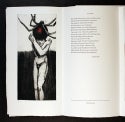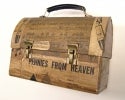Introduction and Highlights
In the fifteen years since the landmark Treasures of Lauinger Library exhibition, Georgetown’s Special Collections have been enriched by a tremendous outpouring of generosity. As we mark the opening of the Booth Family Center for Special Collections, the newly renovated Center’s inaugural exhibition pays homage to the many donors who since 2000 have given books, manuscripts and artwork, as well as funds that enable the Center’s curators to take advantage of opportunities as they arise in the antiquarian marketplace. This case highlights a few newly acquired treasures, from the extremely rare Eliot Bible—the first Bible printed in America—to the transformative gift of the Paul F. Betz Collection of Wordsworth and English Literature. We are grateful to the many donors who have made it possible for us to collect and preserve these items for future students and scholars.
The Holy Bible, Containing the Old Testament and the New. Translated into the Indian Language...
[Eliot Bible]
John Eliot, translator
Cambridge, Massachusetts, 1661-1663
This missionary translation into the Massachusett language was the first complete Bible to be printed in the Western Hemisphere. Because of England’s strict monopoly on Bible printing, an English-language translation would not be printed in America until 1782. The Eliot Bible is a superb complement to the extensive holdings on Native American linguistics in the John Gilmary Shea collection. This magnificent gift fills one of the major gaps in Georgetown’s collection of historic Bibles.
Gift of a member of the Georgetown University Board of Directors
"The Picasso" (Commonplace Book)
Graham Greene
Undated, ca. 1976-1991
Leopoldo Durán papers
After Spanish priest Leopoldo Durán (1917-2008) wrote his doctoral dissertation on Graham Greene, Greene invited him to lunch at the Ritz in London, initiating a fast friendship. Beginning in 1976, Durán and Greene embarked on a series of annual holidays. Their travels through Spain inspired Greene’s novel Monsignor Quixote (1982), which Greene dedicated to Durán. Perhaps the last major Greene archive to enter an institutional collection, Durán’s papers include this remarkable volume, which Durán gave Greene to jot down notes about his thoughts and readings. Durán nicknamed it “The Picasso,” having conceived the idea after a visit to the Picasso Museum in Antibes.
Purchase, Lynn R. and Robert M. Callagy Philanthropic Fund
Tintype photograph of an unknown pre-Civil War Georgetown College Cadet and a cadet uniform button bearing the College Seal, ca. 1860
The College Cadets were first organized in 1832. Between 1852 and 1860, at least 175 students mainly from Southern states served in two companies and took part in bayonet drills, target practices, and marching exercises. The cadets represented Georgetown at public events and served as escorts for distinguished visitors to Washington, D.C.
A tintype is a photograph made by creating a direct positive on an iron plate coated with a black lacquer or enamel. Tintypes enjoyed the longest popularity of any 19th-century photographic process. Tintype portraits, like the one of our unknown cadet, were initially made in photographic studios. Later they were made by photographers at fairs or by itinerant sidewalk photographers—because their lacquered coatings did not need to be dried, tintypes were ready within minutes.
Gift of the Liljenquist Family
Abraham Lincoln-George B. McClellan Letter
Autograph letter, dated 20 January 1862, signed by President Abraham Lincoln to Union General George B. McClellan, inquiring whether George Patten, a pro-Union man from South Carolina, would make a good officer. McClellan’s reply, written on the bottom of the same document and on its verso, presumes Patten would, indeed, make a good officer.
Miscellaneous Manuscripts collection 1
Gift of Mary Fearey
"Sonnet, on Seeing Miss Helen Maria Williams Weep at a Tale of Distress"
[William Wordsworth (1770-1850)]
The European Magazine
Volume 11, 1787
Wordsworth’s pseudonymous first appearance in print (AXIOLOGUS in Greek means “word’s worth”). He would go on to become one of the most influential poets in the English language. In 2014 Professor Emeritus Paul F. Betz donated the first installment of his collection of Wordsworth and English literature. The collection has been called an “achievement … unmatched of its kind in our time.” This transformative gift will position Georgetown as one of the most internationally significant destinations for the study of Wordsworth and of British Romanticism generally.
Gift of Paul F. Betz
As the institutional memory of Georgetown University, the Archives preserves and makes available records of enduring value that document University activities, policies and programs. Since 2000, donations from private individuals and purchases made with donated funds have significantly enriched the collection. Some of these additions, like the Civil War-era student letter on display, provide new windows into the history of student life at Georgetown. Bringing its collections into the twenty-first century, the Archives is now emphasizing the importance of preserving "born-digital" records—including University-related Tweets. Also on display are a few items that have been part of Special Collections for far longer than fifteen years, but that were recently conserved or digitized, now making them more readily available to students and scholars.
University Archives
Proceedings of the Philodemic Society, September 25, 1830 –July 25, 1837
Open to the entry for the Society’s fourth meeting held on January 18, 1831, at which it was resolved to adopt some appropriate badge or emblem, which each member shall wear on particular occasions.
In the fall of 1830, a group of 33 students met to organize a debate society, subsequently named the Philodemic Society of Georgetown College. The topic chosen for their first debate was: Who was the greater man, Napoleon Bonaparte or George Washington? Unsurprisingly, Washington was judged greater.
The badge adopted in 1831 took the form of a two-sided shield. On the front appears the American eagle, a trident in one claw and the other resting on a globe. On the reverse, Mercury (god of eloquence) clasps hands with the goddess of liberty. The shield bears a Latin inscription: Colit Societas Philodemica E Colegio Georgiopolitano Eloqentiam [sic] Liberati Devinctam [The Philodemic Society of Georgetown College cultivates Eloquence devoted to Freedom].
Conservation of this volume was funded by an anonymous donation in 2011. It was one of the first items from the University Archives to be added to the Georgetown University Library’s DigitalGeorgetown website, where it can be viewed in its entirety.
Cadet Schottisch, respectfully dedicated to the George-Town Cadets, by Pedro A. Daunas, 1855
Spanish-born Pedro Antonio Daunas joined the Georgetown faculty in 1850 and organized a student orchestra, the Philharmonic Society, which performed at commencements and other College events. In addition to teaching and serving as college organist, he composed both sacred and secular music. Examples of both are preserved in the University Archives.
Gift of Eric Wind (F’ 2009)
Scorebook for Georgetown College Base Ball Clubs, 1869-1873
Baseball became popular on campus after the Civil War. This scorebook documents games played by the Stonewall, Quickstep, and Georgetown College Base Ball Clubs. External opponents include the University Base Ball Club of Columbian College, the National Base Ball Club of Washington, and the Mountaineers of Mount St. Mary’s College, Emmitsburg.
This item was conserved in 2013 and can be viewed in its entirety on the Georgetown University Library’s DigitalGeorgetown website.
Floor plan for Healy Hall by Smithmeyer & Pelz, Architects, as printed in American Architect and Building News, March 27, 1880
Work began on Healy Hall in late 1877. It was designed to provide space for science labs, a library, an auditorium, classrooms, and dorm rooms. These dorm rooms, on the third and fourth floors on the plan, were originally available to senior students only, for an added fee. Before Healy opened, all Georgetown dorms were communal, an arrangement that many of the older students disliked—some even left, citing that as the reason.
Gift of Richard J. Cellini (C’1984, L’1988)
View from top of Washington Monument looking towards Georgetown, ca. 1884
Showing the view towards Georgetown from the top of the Washington Monument around the time the Monument’s completion, this image offers an unusual perspective of campus. Healy Hall, the only campus building to be easily discernible, is seen toward the top center.
This item was conserved in 2013.
List of Lay Nurses, 1903-1908. Open to the application by Lillian Neale Welker for admission to the Georgetown University Hospital Training School for Nurses
Women have studied at Georgetown continuously since the founding of the Training School for Nurses in 1903. The School was established to provide support for the University Hospital, which opened in 1898. Its first class of students, among them Ms. Welker, graduated in 1906.
This item was discovered in a credenza in the School of Nursing and Health Studies in 2009. It was brought to the attention of Bill Cessato, Director of Communications for the School, who facilitated its transfer to the University Archives so that it could be permanently available for research use.
Transfer from the School of Nursing and Health Studies, 2009
Georgetown sports-themed Murad tobacco silks, ca. 1906
American tobacco companies began including fabric swatches in their packaging as promotional items between 1906 and 1910. Although these swatches were most commonly satin, they came to be known as tobacco or cigarette “silks.” Companies encouraged women to fashion them into household items such as quilts or pillows—in fact, the inclusion of silks may have been a marketing strategy to encourage women to smoke. The silks on display form part of a set depicting idealized Georgetown athletes.
Purchase and gift of Eric Wind (F’2009)
Scrapbook of Harold M. Clements (C’1930)
This scrapbook of “School Memories” was kept by a Georgetown student from Houston, Texas. With dance cards, menus, snapshots of campus, and tickets to athletic and other events, it documents student life, interests, and activities in the late 1920s. Among the items on view are a flyer supporting the candidacy of Joseph C. “Joe” Tanous (C’1932) for Class President and a guest ticket to the Democratic National Convention, June 1928. This convention nominated Governor Alfred E. Smith of New York for President—Smith, an opponent of Prohibition, was the first Roman Catholic Presidential nominee of a major political party.
Gift of David J. Clements
Photograph of the New Georgetown Lightweight Crew in the 1964 Crew Media Guide and program from the Dad Vail Regatta, Schuylkill River, Philadelphia, May 12, 1962, at which Georgetown won the Varsity and Junior Varsity races. Crew Alumni Collection
2014 saw the publication of Never Row: A History of Georgetown Crew 1958 to 1969 by Edward P. Witman (assisted by John Soisson, C’1967), illustrated by Linda Lovas Hoeschler. Mr. Witman then donated his research material for the book to the University Archives. This material, which includes items from Martha Hoffman, forms the nucleus of the Crew Alumni Collection, a group of documents that adds significantly to crew records already held by the Archives. Ms. Hoeschler and Mr. Witman are working to expand the collection by organizing the donation of additional material from crew alums.
Gift of Edward P. Witman (C’1967) and Martha Hoffman
Items from the Albert Lincoln Hoffman, III (B’1965) Crew Scrapbooks and Photographs Collection
This collection includes hundreds of photographs, many of them unique. Its donation to the University Archives does much to enhance photographic documentation of Georgetown crew in the early to mid-1960s. Displayed are photographs of: the 1963 Junior Varsity;
Don D. Cadle, who coached from 1960-1964 (in the Georgetown shirt); and the 1965 Varsity at Marietta, 4/10/1965 (with Rick Reynolds, Jim Woods, Bill McNeill, Ed Witman, Mike Ryan, Pete Blyberg, John Soisson, Linc Hoffman and Art Charles, coxswain).
Gift of Martha Hoffman
Poster from an evening with poet Allen Ginsberg in Gaston Hall, February 29, 1968
Ginsburg was invited to campus by the Student Government’s Cultural Committee, chaired at that time by Mr. Church. Ginsberg recited many of his poems and took questions from a packed crowd in Gaston Hall. A review of the evening was printed in the March 7, 1968 issue of The Hoya , which is available on DigitalGeorgetown.
Gift of Al Church (C’1968)
Demonstration Info, ca. 1970, and flyer for the first Earth Day, April 22 [1970]. From the Washington, D.C. Ephemera Collection (1967-1972)
In addition to material that documents life on campus, the University Archives holds collections that reflect events and issues in the wider D.C. area. The Washington, D.C. Ephemera Collection (1967-1972), which includes flyers, pamphlets, and newspaper cartoons on political themes largely not specific to Georgetown, was collected by Mr. Worden, a Georgetown graduate student from 1967-1972.
Gift of Robert L. Worden (G’1972)
Photographs of the May Day Riots, 1971 from the John E. Carmody (F’1973) Student Collection
The John E. Carmody (F’1973) Student Collection contains material reflective of student life at Georgetown from 1969 to 1973. It includes Georgetown publications, flyers, and other ephemera. Much relates to student activism, particularly protests against the Vietnam War. The items displayed relate to the May Day Riots in Washington, D.C., in 1971.
During the weekend of May 1-2, 1971, Washington was inundated with protestors against the Vietnam War. Most of the protestors camped in West Potomac Park. Early on the morning of Sunday, May 2, police cancelled their camping permit and evicted them from the park. Many were told that the University had opened to protestors and, throughout the day, a steady stream arrived on campus, setting up tents on the athletic fields and—once it began to rain—filling every dorm. The protestors were peaceful and the University let them stay, having concluded that it would be almost impossible to clear the buildings. They left early the next morning.
After 8 a.m. on May 3, waves of demonstrators who had been attempting to block traffic were driven through the streets of Georgetown by police using tear gas. As the gas reached campus, a decision was made at 9:15 a.m. to cancel exams—15 minutes before the exams were due to start. An area for washing off pepper and tear gas was set up in the Bles Building and student marshals worked, at great personal risk, to try to keep police and demonstrators apart. By 4:15 p.m. the demonstrators, who were estimated to have reached about 2,500 in number, had left campus. There were no reports of serious personal injury and, surprisingly, property damage was quite limited.
Gift of John E. Carmody
Photographs of night filming on Prospect Street with actor Lee J. Cobb in his last major Hollywood role and director William Friedkin, October 1972. From the Shooting of The Exorcist Movie Collection.
The Exorcist crew spent approximately twenty days filming in the Washington area, including seven days on campus. Around 300 student extras appeared in the production, mainly in crowd scenes. Some Jesuits and faculty members also appeared. Professor Chieffo was one of the University liaisons to Warner Brothers Studios, which produced the movie. The movie was based on the bestselling novel of the same name, written by William Peter Blatty (C’1950). Mr. Blatty won an Academy Award in 1973 for the movie’s screenplay.
Gift of Clifford T. Chieffo, Professor of Art, Music and Theater Emeritus
Sports Illustrated, April 4, 1984: ”Slammin’ the Jammas! Georgetown Beats Houston for the NCAA Title” and Sports Illustrated, November 26, 1984: ”There They Go Again. John Thompson, President Reagan, Patrick Ewing’
On April 2, 1984, Georgetown met Houston in the National Championships in the Seattle Kingdome. The 84-75 Georgetown victory was a triumph of teamwork, domination, and intimidation. Making use of his team’s remarkable depth, Coach John Thompson, Jr. was able to keep sending in fresh players and Houston was unable to counter them. Five Hoyas scored in double figures: Reggie Williams scored 19; David Wingate16; Michael Graham 14; Michael Jackson 11; and Patrick Ewing 10. Ewing also led the team in rebounding with nine boards and was named the tournament MVP.
Transfer from former Athletic Director Francis X. Rienzo
Script from a season four episode of West Wing, filmed on Georgetown’s campus in April 2003
Requests to film movie or television scenes on campus or for use of Georgetown objects in movies or television shows are vetted by the Office of Protocol and Events. Part of the vetting process includes a script review. This script was submitted for review ahead of filming for a West Wing episode titled “Commencement” on Healy Lawn. In this episode, which aired on May 7, 2003, West Wing President Josiah Bartlett (played by Martin Sheen) speaks at the Georgetown graduation of his daughter Zoey Bartlett (played by Elizabeth Moss).
Transfer from the Office of Protocol and Events
Items from the inauguration of the McCourt School of Public Policy, 2013
Alumnus Frank H. McCourt, Jr. (C’1975) gave a record gift of $100 million to endow Georgetown’s newest school, the McCourt School of Public Policy. Founding exercises for the School were held on October 8, 2013 and were the first to be held for a new School at Georgetown since the founding of the Edmund A. Walsh School of Foreign Service in 1919.
Transfer from the Office of Advancement
Record of Tweets captured for Georgetown University’s official Twitter handle, @Georgetown, and Tweets captured for the hash tag #WelcomeJJ, 2013
Universities are increasingly using various social media platforms to interact with the world and Georgetown is no exception. The University Archives is exploring ways to save content posted on social media platforms as a new way to document the history and activities of Georgetown University. One such platform that we are experimenting with is Twitter. This display shows a list of tweets captured for digital preservation that reference the official Georgetown University Twitter account, as well as tweets documenting the arrival of Georgetown’s former mascot JJ.
This case reflects several of Georgetown’s major collecting areas, from Catholic literary figures to military intelligence, from the Saudi peninsula to the isthmus of Panama, from the Society of Jesus to American diplomacy. Donations since 2000 have included important literary manuscripts, such as a draft poem by Dante Gabriel Rossetti, to monuments of erudition such as Charles Thomson’s autograph translation of the New Testament. Other recent acquisitions have rescued significant archives from permanent loss: the papers of the English man of letters Montague Summers, for example, were declared lost to scholarship decades ago. Georgetown acquired them after they were discovered languishing in an old farmhouse in Manitoba. Cutting across all these fields, women’s history is represented in this case and elsewhere in the exhibition by the papers, books, music, and artwork of many outstanding women—in several instances the first of their gender in their chosen fields.
Manuscripts
Dante Gabriel Rossetti
Draft version of the Burden of Nineveh, circa 1850-1856.
The Burden of Nineveh was first published anonymously in The Oxford and Cambridge Magazine in 1856. Rossetti (1828-1882) initially began work on the poem in 1850, then had it published in 1856, and later revised it when it was again published in 1870. The poem is an important literary expression of Pre-Raphaelite principles.
Crocker-de Limur collection
Gift of Mary Weinmann and Charles de Limur
Isaiah Garrett, Jr.
“A rumor was out that an attempt was to be made to burn down the College, and guards are stationed all around it every night. . .”
Isaiah Garrett, Jr., student at Georgetown College from Louisiana, writing to his brother about the mood and heightened feelings regarding secession from the Union in Washington, D.C. and at the College, 19 January 1861. Rumors about attempts “to fire the college” have not been previously documented, and reflect the perilous position in which Georgetown as a Southern-leaning institution found itself at the onset of the Civil War. The more than 40 letters in this collection add substantially to holdings reflecting student perspectives, hitherto under-documented for this period.
Isaiah Garrett, Jr. letters
Purchase, the James Ethelbert Morgan Memorial Fund
Joyce Kilmer’s notebook, which includes “Trees,” 1911-1913
“I think that I shall never see
a poem lovely as a tree . . .”
Alfred Joyce Kilmer (1886-1918) was a poet, critic, and soldier. Trees and Other Poems was published in 1914, and the poem “Trees” attained worldwide fame. Kilmer enlisted in the Army shortly after the U.S. entered the fray and was part of the 165th Regiment. He was killed by an enemy bullet near Seringes-et-Nesles, France on 30 July 1918. He had continued to write poetry and was also writing a historical account of the 165th Regiment. Widely regarded as one of the leading Catholic literary figures of his generation, Kilmer’s papers greatly enrich Georgetown’s extensive Catholic literature collections.
Joyce Kilmer papers
Gift of Miriam A. Kilmer
Photo album from a 4 July 1959 party at the home of Prentiss Taylor in Arlington, Virginia
“While two old friends ponder reservedly . . . “
Prentiss Taylor appears in the lower photograph with I. W. Perkins.
Prentiss Taylor papers
Gift of Roderick S. Quiroz (G’1991)
Pencil drawing of a farm near Nethers, Virginia, circa 1938
From Taylor’s notebook number 4, 1938-1940
Prentiss Taylor (1907-1991) was a lithographer, painter, and illustrator from Washington, D.C. He studied at the Art Students League and under Charles H. Hawthorne in Provincetown, Massachusetts. During the 1930s, he befriended Carl Van Vechten and collaborated with poet Langston Hughes in publishing booklets significant to the Harlem Renaissance. Taylor returned to Washington in 1935, widely exhibited his work and associated with many organizations. He taught painting at American University from 1955 to 1975. The collocation of Georgetown’s Art and Manuscripts collections in a single Special Collections department greatly facilitate collecting of and research in both an artist’s papers and artwork, as with Georgetown’s Prentiss Taylor holdings.
Prentiss Taylor papers
Gift of Roderick S. Quiroz (G’1991)
World War I U.S. Army jacket
Edward Loughborough Keyes (1873-1949) received his A.B. from Georgetown in 1892, M.D. from Columbia in 1895, and a Ph.D. from Georgetown in 1901. He went on to hold academic positions in urology at Georgetown, New York University and the Cornell University Medical College. He authored the premier urology textbook of his day, Urology. Dr. Keyes served in World War I as consultant in urology to General John J. Pershing, and rose to the rank of colonel. During the war he and Hugh Young led modern history’s first public campaign against sexually transmitted disease, and in America he was one of the leaders of the American social hygiene movement from which contemporary sexual education evolved. He also wrote poetry and prose profusely.
Edward Loughborough Keyes papers
Gift of Edward Belt
Edward Loughborough Keyes
“I wish I could see the end of this dreary and murderous business, but the signs point to a long pull yet. . . . But we are the pampered ones and have no right to kick.”
Letter from Dr. Keyes to Thomas Walsh where he describes traveling around France visiting various camps and posts, noting that he has not run into Joyce Kilmer, and lamenting the ongoing war, 28 June 1918.
Edward Loughborough Keyes papers
Gift of Edward Belt
Gerald Lankester Harding, circa 1960s
Photograph of Harding taken by William Peter Blatty in Lebanon. Harding was Blatty’s physical model for the character of Father Lankester Merrin in the novel The Exorcist.
Misc Manuscripts 4
Gift of William Peter Blatty (C’1950, G’1954)
Letter from William S. Bowdern, S.J. to William Peter Blatty, 19 February 1971.
Blatty consulted Father Bowdern regarding exorcisms while conducting research for his novel The Exorcist.
William Peter Blatty papers
Gift of William Peter Blatty (C’1950, G’1954)
“I had outlived the Soviet Union” – Richard M. Helms
Signed autograph letter dated December 25, 1991, from Richard M. Helms (1913-2002) to his son Dennis Helms and his daughter-in-law Meg Helms, reflecting on his career. Having served as Director of the Central Intelligence Agency at the height of the Cold War (1966-1973), he notes that he has outlived the Soviet Union.
Richard M. Helms papers 2
Gift of Mrs. Cynthia Helms
The 1946 Constitution of the Republic of Panama
Photograph of Esther Neira de Calvo signing the Panamanian constitution on March 1, 1946, displayed with a copy of the 1946 Constitution. She helped draft the document as an elected National Constituent member. Esther Neira de Calvo (1890-1978) was a noted educator, politician, diplomat, and feminist in Panama. Her papers are a noteworthy addition to Georgetown’s extensive holdings relating to Panama and the Canal.
Esther Neira de Calvo papers
Gift of Gloriela Calvo
James H. McCartney Papers
As a Washington correspondent for Knight-Ridder Newspapers, James H. McCartney (1925-2011) covered domestic politics, foreign affairs, and defense policy, and was an important critic of the military-industrial complex. He was also a well-loved Georgetown adjunct professor.
Telex from James H. McCartney about U.S. President Jimmy Carter’s efforts at Middle East Peace in 1979. McCartney sent telexes (via a telephone-like network that predated fax machines and email) to his editor, who would choose how much of an article to reproduce in the final printed version in a newspaper.
Press Pass for December 1987 Summit between Reagan and Gorbachev in Washington, D.C.
Photograph of McCartney speaking with President George H.W. Bush in the Oval Office in 1990.
Gift of Molly Sinclair McCartney
William H. Jackson
Signed typed letter dated 11 April 1956 from President Dwight D. Eisenhower to William H. Jackson (1901-1971), appointing him Special Assistant to the President and detailing his new responsibilities. In that position, Jackson would attend meetings of the Cabinet, National Security Council, and Council on Foreign Economic Policy. Jackson previously served as Deputy Director of the Central Intelligence Agency (1950-1951), and his papers strengthen Georgetown’s substantial holdings relating to the history of intelligence and espionage.
William H. Jackson papers
Purchase, Russell J. Bowen Fund
Robert Hopkins Papers
The son of Harry Hopkins, New Deal architect and closest of advisors to Franklin Roosevelt, Robert Hopkins (1921-2006) enjoyed a unique perspective on the events of World War II and the Cold War which followed. As a Signal Corps combat photographer, Hopkins covered the Allied campaigns in North Africa, Sicily and Italy, as well as the preparations and immediate aftermath of the Normandy invasion. He ultimately received orders to document the four great conferences at Casablanca, Cairo, Teheran, and Yalta, producing the most widely known images of these events including the first meetings of the ”Big Three.” After the war, Hopkins began a long career with the CIA during the Cold War, serving in Europe, South America, and Washington, D.C., eventually retiring from Federal service in 1980. His papers, which complement those of his father, also at Georgetown, feature many of his wartime photographs, family letters and records of his career in the CIA.
Bequest of Robert Hopkins
- Photograph of Robert with Harry Hopkins, Casablanca, 1943
- Photograph of Winston Churchill, Franklin Roosevelt and Joseph Stalin, with staff, at the “Big Three” conference at Yalta, 1945
- Letter from Harry to Ethel Hopkins, February 2, 1943
- Robert’s diary from Cairo-Teheran Conference, 1943
- Typed extracts from Cairo-Teheran Conference Diary, 1943
- Letter from Robert to Ethel Hopkins regarding Cairo and Teheran, January 21, 1944
- Hopkins ‘ official war photographer identification card, 1943
Montague Summers Papers
Reverend Augustus Montague Summers (1880-1948) was a prolific and popular polymath. Best remembered today for his books on the history and literature of witchcraft, vampires, and other occult subjects, “Monty” Summers also published groundbreaking scholarly studies and editions of Gothic literature and English Restoration drama, and anthologies of Victorian ghost stories and other weird fiction. He still found time to revive Restoration theater, producing plays not performed since the 17th century. Summers cultivated a mysterious, even sinister, aura around his public persona, an aura which grew posthumously, not least due to the disappearance of his papers soon after his death. Thought lost for more than 60 years, the collection turned up in Canada in the custody of relatives of Summers’s personal secretary before finding its way to Georgetown.
Purchase
- Summers’ popularity spanned both sides of the Atlantic: Letter from the popular British author of thrillers Dennis Wheatley to Summers, August 19, 1935
- Two manuscript pages: first page of The Grimoire; first page of the introduction to The Grimoire by Summers. Displayed with The Grimoire, 1936, 1st edition
- Photograph of Summers, reproduction
Dorothy Miller Photographic Collection
Dorothy Miller arrived in Saudi Arabia in 1947 to work in the law department of the oil company Aramco. She became interested in photography after meeting chief Aramco photographer Tommy Walters in Dhahran in 1949. Eventually, Miller learned to do her own developing and by 1959 had garnered enough attention for her hobby that she decided to take an intensive six-week professional photography course at the Brooks Institute in San Francisco. Miller returned to Aramco in 1967 as treasurer. Her passion for photography unabated, she continued to take hundreds of stunning photographs ranging from Aramco staff and facilities to the people and countryside of Saudi Arabia. Locations depicted include Abquaiq, al-Khobar, Dhahran, Dammam, Hofuf, and Qatif. Miller retired from Aramco and returned to the U.S. in 1977. Since then her photographs have been exhibited at Georgetown University Library in 2007 and at the Saudi Aramco Heritage Gallery in Dhahran in 2008.
Gift of Dorothy Miller
- Photograph by Dorothy Miller of a date picker in Qatif, 1976 Reproduced from original
- Photograph by Dorothy Miller of a little girl in a black dress, Yemen, 1977Reproduced from original
Shirley Hazzard Papers
Shirley Hazzard (1931- ) was educated in Sydney, Australia. She began her career with the British Combined Services Intelligence in Hong Kong, where her father was appointed Australian trade commissioner. Subsequently, she followed her family to postings in Wellington, New Zealand, working for the British High Commissioner to London; and ultimately to New York in 1950. Hazzard remained in the U.S. after the departure of her parents in 1951, obtaining citizenship and a position with the United Nations, under whose auspices she spent a year in Italy. She also began writing short stories; the first was published in The New Yorker. Hazzard resigned from the U.N. in 1962, in order to focus on writing. She cemented her literary reputation with her novel The Transit of Venus (1980), for which she received worldwide recognition. In 1963, Hazzard married biographer and novelist Francis Steegmuller (1906-1994). Together they cultivated a circle of significant literary friendships, including Graham Greene. Their relationship with Greene on the island of Capri is recollected with Hazzard's characteristic perspicacity and appreciation of human nature in her book Greene on Capri (2000).
Gift of Shirley Hazzard
- Photograph of Graham Greene at De Gemma restaurant on Capri. Undated. Reproduced from original
- Ristorante De Gemma menu
- Shirley Hazzard. Greene on Capri (New York: Farrar, Straus and Giroux, 2000). First edition.
Clare Boothe Luce Photographic Collection
Clare Boothe Luce (1903-1987) was an editor for such well-known magazines as Vogue in 1930 and Vanity Fair from 1929 until 1934. As a playwright, her most successful works include The Women (1936), Kiss the Boys Goodbye (1938), and Margin for Error (1939), all produced on Broadway. In 1935 she married publishing mogul Henry R. Luce. During the 1940s, Luce became increasingly active in politics. She was elected to the House of Representatives in 1943 and 1944. Dwight D. Eisenhower appointed her as ambassador to Italy from 1953 to 1957. Throughout her life, Luce was involved in many humanitarian organizations including the American Friends of Captive Nations, American Security Council, International Rescue Committee, and U.S. Committee for Refugees, among others. Luce also wrote Europe in the Spring (1940), an account of her travels in Europe at the onset of World War II.
Gift of Clare Boothe Luce Estate
- Clare Boothe Luce. Photograph with Chiang Kai Shek and wife in Burma, 1942
Princess Niloufer Collection
Princess Niloufer (1916-1989), was one of the last members of the Ottoman Empire royalty. Childless herself, Princess Niloufer’s great love of children was galvanized by the death of a maid during childbirth and the lack of a specialized hospital for women and children in Turkey. As president of the Hyderabad Women and Children’s Medical Aid Society, Princess Niloufer founded the Niloufer Hospital in Hyderabad, India, in 1949. With specializations in maternal and pediatric medicine, the hospital opened in 1953. UNICEF aid provided further development of services, and nurse training programs were funded under the auspices of the World Health Organization. Today, more than a thousand children a day are treated on an outpatient basis.
Gift of Evelyn M. Pope
- Photograph of Princess Niloufer. Undated. Credit: Raja Deen Dayals. Nizam’s State Photographers. Secunerabad.
- Beaded bracelet decorated with black and white photographs of Niloufer and husband Prince Muazzam Jah.
Mata Hari
Mata Hari (1876-1917), was born Margaretha Geertruida Zelle. A native of the Netherlands, Zelle traveled to Java, Indonesia, at eighteen in response to an advertisement for marriage placed by Rudolf MacLeod, an army captain from Skye. The marriage ended in divorce in 1907. Over the years, Zelle sought solace and escape from domestic circumstances by immersion in Indonesian culture, especially traditional dance forms. In 1903, she moved to Paris, where she performed on horseback and supplemented her income by posing as a model for artists. She was able to travel freely across borders during World War I because of the Netherlands’ neutrality, but unfortunately her movements drew attention. In 1916, en route from Spain to England, she was detained by Scotland Yard for questioning. She was eventually released, but in 1917, radio messages between Madrid and Berlin reporting on activities of a German spy were intercepted by French intelligence, which identified the spy as Mata Hari. Zelle was arrested in Paris, tried, found guilty of treason, and executed by firing squad on October 15, 1917. In 1985, sealed official case documents were opened at the behest of biographer Russell Warren Howe, who was able to reveal that Zelle was innocent.
Purchase, Russell J. Bowen Fund
- Mata Hari. Four signed autograph letters to Jean Hallaure, with whom Zelle was romantically involved, circa1916; in French. Reference to obtaining safe passage to Vittel, a spa that Zelle frequented. Hallaure was a second lieutenant in the Deuxiѐme Bureau (the intelligence branch) of the Ministry of War, Paris, and was responsible for bringing Zelle to the attention of his superior, Georges Ladoux, head of the Deuxiѐme Bureau. Ladoux undertook to gather evidence against Zelle which led to her arrest.
The New Covenant, Commonly Called the New Testament
[Thomson’s Bible]
Charles Thomson
Ca. 1789-1808
Charles Thomson (1729-1824) served as Secretary to the Continental Congress throughout the American Revolution. When he retired in 1789, Thomson began the monumental task of translating the Bible from Greek into English. When it was published nearly two decades later, it was the first English translation of the Bible by an American, the first translation of the Greek Septuagint directly into English, and the first Bible to be printed by an American woman. On display is Thomson’s manuscript of the New Testament, open to the first page of the Gospel of John. The numerous corrections and insertions include changes even to the well-known first verse.
Gift of a member of the Georgetown University Board of Directors
Miscelanea Historica-Politica. Compendio. De lo acaecido en el establecimiento de la Linea Divisoria … Demarcado en la America Meridional
[Spanish Boundary Commission Report]
[Madrid], 1750-1760
The events depicted in the 1986 film The Mission were set in motion by the proceedings described in this manuscript. In 1750 the Spanish and Portuguese sent an expedition to enforce a treaty establishing new boundaries in their American territories, including that between Paraguay and Brazil. The native Guarani, aided by Jesuit missionaries, rebelled in 1754 against the change in the jurisdiction of their settlements (“reductions”): though protected under Spanish law, Guarani converts would be subject to enslavement under Portuguese rule. A joint Spanish and Portuguese force finally put down the insurrection in 1756. On display is the first page of an argument against the legitimacy of the Jesuits’ actions in Paraguay.
Gift of Rolando Gonzalez-Bunster (C’1968, P’2016)
Saint Roberto Bellarmino, S.J.
Autograph Letter, Signed
21 August 1620
The prominent Counter-Reformation figure Cardinal Robert Bellarmine (1542-1621) was a prolific author and controversialist and played a role in warning Galileo against Copernican heliocentrism. Bellarmine writes here to his nephew, Marcello Cervini, about the challenges of having books translated between Latin and the vernacular.
Gift of Gerard O’Brien
University Art Collection
The Art Collection has grown tremendously over the past fifteen years thanks both to donations and to the Charles M. Fairchild Endowment Fund for the purchase of fine prints. Several substantive research collections are represented here, including the Jeff Perry Collection of fine photographs and the Prentiss Taylor and Rosemary Covey collections. Other items round out our holdings with examples of monumental moments in art history, including fine examples of the work of master printmakers like Rembrandt and Goya. This case demonstrates the collection’s range—from a woodcut from the Nuremberg Chronicle (1493) to a ‘60s silk-screened poster. It also showcases the collection’s potential to support student learning. The etched aquatint plate by John Taylor Arms, for example, will foster opportunities for students to learn about process and connoisseurship from a superb example of an original printing matrix.
Entrance of Calais Harbor
Joseph Mallord William Turner
1816
First of two states
Etching and mezzotint
The famous British landscape painter J.M.W. Turner was inspired by his predecessor Claude Lorrain (ca. 1600-1682) to publish a series of engraved views known as the Liber Studiorum, or Book of Studies, after Claude’s so-called Liber Veritatis or Book of Truth. Turner’s undertaking had the dual goal of generating revenue for the artist while serving to elevate the status of the landscape genre in the artistic hierarchy dominated by history painting. This image with a wind-tossed sailing vessel, a favorite subject of Turner’s, was based on one of his earlier paintings. Turner inspired later generations of American artists dedicated to the grandeur and sublimity of nature, especially Thomas Moran, who collected his idol’s Liber Studiorum prints and traveled to England to study Turner’s paintings. Entrance of Calais Harbor is an extremely rare first of two states, and one of the eleven (from a total of seventy-one) plates engraved solely by Turner’s hand without the collaboration of other printmakers.
Purchase
Eve and the Serpent
Frank Morley Fletcher and John Dickson Batten
1895
Color woodcut
Designed by Frank Morley Fletcher and printed by John Dickson Batten, Eve and the Serpent was the first British print created in the Japanese Ukiyo-e woodcut technique, as announced by Batten in The Studio magazine a year later. Batten also described the process in detail, which had replaced hand-coloring in 18th-century Japanese prints. Made from hard wood, often boxwood, Ukiyo-e prints required a separate, hand-carved block for each color (in this case six), which would produce a multi-color image when printed simultaneously. Pre-Raphaelite in style, this very rare impression is known to exist in just two other public collections, at the British Museum and the University of Glasgow.
Purchase
In Between
Pavel Makov
2005
Intaglio, edition 49/70
From the portfolio Drawn to Representation
Published by the Corcoran Gallery of Art
Evoking the miniature walled cityscapes of Gothic paintings, In Between was produced as part of the Corcoran Gallery of Art’s 2005 print portfolio, Drawn to Representation. This ambitious project, curated by Dr. Eric Denker, included prints by 24 international artists. Denker explained in the brochure that his selections celebrated “a continuing interest in the traditional craft of printmaking, and the ongoing use of representation as a viable mode of artistic expression.” Ukrainian artist Pavel Makov appears to have used antique laid paper with random imperfections such as a hole in this impression, effectively harkening back to another era in both imagery and use of materials.
Donative purchase, Corcoran Gallery of Art
Portrait of John Morrell
Arthur Hall Smith
1976
Brush drawing
This finely rendered portrait drawing, executed using the tip of the brush, portrays Georgetown’s Professor of Studio Art John Morrell when he was a graduate student studying with Arthur Hall Smith at George Washington University. Smith taught for twenty-three years and was celebrated in a 2013 retrospective at GW following his death in Paris, where he had lived permanently since his retirement in 1997. A distinguished and talented artist, Smith studied under Stanley William Hayter in Paris and with American abstract artist Mark Tobey, and is known primarily for his colorful abstract paintings influenced by his teachers.
Purchase, Charles M. Fairchild Endowment Fund
Dance of Death
Michael Wolgemut
1493
Woodcut
Published in the Liber chronicarum
This macabre woodcut by Michael Volgemut appears in The Nuremberg Chronicle by Hartmann Schedel (1440–1514), an early comprehensive history, including the origins of several major European cities. Wolgemut’s skeletons dancing atop a grave have been particularly influential in the history of visual art and serve as a memento mori, or reminder of mortality. This impression bears the 18th-century stamp of the Bibliothèque Royale (French Royal Library).
Purchase, Charles M. Fairchild Endowment Fund
Three Heads of Women, One Asleep
Rembrandt Van Rijn
1637
Etching on laid paper
Three Heads of Women is a wonderful example of Rembrandt’s tendency to sketch from life directly onto a copper plate, and experiment with various degrees of cross-hatching to create shadow and depth. In this case he studies his subject in three poses: asleep, looking down, and looking out. Rembrandt’s etched plates were reprinted many times after his death, often with additional work in them. This impression is thought to be a 19th-century printing from the original plate. Georgetown’s collection of Rembrandt etchings includes a known forgery which is useful for instruction in connoisseurship.
Gift of Marc and Mary Ann Weber
Woman with Flowers
Paul Berthon
1900
Lithograph from the series Les Maitres de l’Affiche
Printed by Imprimerie Chaix, Paris
Paul Berthon was a successful artist and designer of Belle Epoque Paris, and a number of his lithographs were printed for the popular subscription series Les Maitres de l’Affiche (masters of the poster). Published by Jules Cheret, whose work was also featured, the series of colorful lithographs by leading artists of the day were sold each month to collectors in suites of four, from 1895 to 1900. In addition, a total of 16 special plates were released, each sent to subscribers four times per year. This image by Paul Berthon, thought to represent the actress Sarah Bernhardt (1844-1923), was issued as one of the special plates. Among the many donations over the years from collectors James and Janet Sale were six Maitres de l’Affiche prints, including two by Cheret.
Gift of James and Janet Sale
Little Israel (Venice)
Herman Armour Webster
1930
Drypoint
Herman Webster was an American expatriate in Paris who made a successful career selling his etchings through print dealers in New York and Chicago. While a student at the Académie Julian, Webster became inspired by Charles Meryon’s notable views of 19th-century Paris. At that time there was a revival of interest in the art of etching. Webster began exhibiting his etched views of Paris at the Salon des Artistes Français to critical acclaim and his prints were reproduced in periodicals. He was honored with membership in the Royal Society of Painter-Etchers in London, under the direction of Sir Francis Seymour Haden. In 1927, Webster was awarded the prestigious Chevalier de la Legion d’Honneur by the French government. Webster had a long and prolific career, and Georgetown holds an impressive collection of his work thanks to generous donations from Mr. Ciro Taddeo, who recognized the merit of this under-appreciated artist. A future exhibition is planned.
Donative sale, Ciro R. Taddeo
Portrait Bust of Archbishop John Carroll
Jerome Connor
Bronze, from plaster cast ca. 1912
Irish-born sculptor Jerome Connor was commissioned by Georgetown’s Society of Alumni to create a statue of founder John Carroll to be unveiled in May of 1912. Following this success, the sculptor received commissions for a statue of Irish patriot Robert Emmet (now at 24th and Massachusetts Avenue, N.W.) and the Angels of the Battlefield, commemorating the sisters who served as nurses on the Civil War battlefront (now at M Street and Rhode Island Avenue, N.W.). Connor returned to Ireland in 1925 to work on a large memorial dedicated to the victims of the Lusitania. He remained there until his death in 1943, and exhibited his sculptures regularly at the Royal Hibernian Academy of Arts in Dublin. This bronze study for the statue in Healy Circle was cast from the original terra cotta for an exhibition and sale in Dublin. The art collection was fortunate to acquire this important piece of Georgetown’s history through a Dublin auction in 2006.
Purchase
Adolescent
From the portfolio Grogh
Prentiss Taylor
1929
Watercolor on paper
Prentiss Taylor, a third-generation native of Washington, D.C., was a leading figure in the fine arts in this area for the second half of the 20th century. His early years were spent in New York’s Greenwich Village, where he created designs for the theater and illustrated writings by Langston Hughes. During this time Taylor became friends with composer Aaron Copland, and created a portfolio of costume designs for Copland’s ballet Grogh.
While in Paris studying with Nadia Boulanger, Copland wrote this one-scene piece composed in 1922-25, inspired by the silent vampire film Nosferatu. His friend Harold Clurman wrote the scenario for Grogh, about a sorcerer who conjures bodies back to life in order to serve him. Since the piece was not a commission it was never produced, but elements of Grogh were incorporated into Copland’s Dance Symphony. Georgetown University is the proud repository of Prentiss Taylor’s complete lithographic oeuvre, generously donated by Roderick S. Quiroz.
Gift of Roderick S. Quiroz
Portrait of Pope Leo X
Philippe de Soye, after Raphael
Engraving published in XXVII Pontificum Maximorum elogia et imagines accuratissime ad vivum aeneis typeis deliniatae (Rome: Antoine Lafréry, 1568), by Onofrio Panvinio
This rare volume by the Augustinian monk Onofrio Panvinio, dedicated to the “illustrious” Alberico I Cybo-Malaspina, Prince of Massa and Marquis of Carrara, presents the biographies and portraits of twenty-seven popes in chronological order. The volume may have been intended as a tribute to the Medici Pope Pius IV, who in 1559 appointed Alberico Governor of Monteleone in the Kingdom of Naples. The volume is part of an impressive collection of more than 800 portrait prints of clergymen donated by James and Mary Holland in 2010.
Gift of James C. and Mary G. Holland
Set Design for Don Quixote
Eugene Berman
1950
Ink, watercolor and gouache on paper
The Russian-born Surrealist painter, set designer and illustrator Eugene Berman moved to America in 1935 after studying in Paris under noted Nabi painters Edouard Vuillard and Pierre Bonnard. Berman was also influenced by Baroque architecture and his work incorporated grand architectural and classical components in dream-like, often somber atmospheric settings. Berman exhibited his paintings in New York and began designing stage sets for the Hartford Music festival. This led to work for the Metropolitan Opera, and collaborations with fellow Russians Igor Stravinsky and George Balanchine on several ballets. This design for a production of Don Quixote in 1950 was never produced, but the Royal Ballet in London mounted a version of it with designs by Edward Burra that same year.
Gift of Richard Ahlborn in memory of Maria Eva Teresita Salazar
Self-Portrait
James Alexander Simpson
1847
Oil on canvas
James Alexander Simpson was Georgetown’s first instructor of drawing and painting. Simpson painted five historic Georgetown landscapes for then president Thomas F. Mulledy, S.J. They were engraved in 19th-century publications and are now iconic works in the University’s art collection. The largest landscape view may be seen in Carroll Parlor in Healy Hall 107. In this self-portrait the artist presents himself as an accomplished master wearing formal attire and proudly wielding the instruments of his craft. The painting was passed down in the artist’s family for generations until it was given to Georgetown in 2009.
Gift of the Estate of Jane R. and Richard M. Frank
Discovery of the Cross
Nicolas Le Sueur, after Bernardin Pinturicchio
ca. 1730
Chiaroscuro woodcut
This woodcut by the French artist Nicolas Le Sueur is an example of the chiaroscuro woodcut technique pioneered some 200 years earlier in Italian prints of the 16th century. The process was developed by artists such as Ugo da Carpi to create the effects of light and shadow in a printed image, imitating the look of a watercolor or wash drawing. In chiaroscuro prints, the line or key block is printed first, followed by the tone blocks for color—usually two—printed in progressively lighter shades and carefully measured to register perfectly, maintaining the clarity of the design. Le Sueur’s image is based on a fresco depicting the Discovery of the Cross by St. Helena, originally painted by the Italian Renaissance master Pinturicchio in the Basilica of the Holy Cross in Jerusalem, one of the seven pilgrim churches in Rome.
Purchase, Charles M. Fairchild Endowment Fund
Day of the Land
Burhan Karkoutly
1990
Lithographic poster
This poster, which commemorates events of March 30, 1976 in Palestine, is part of a growing collection of Palestinian posters at Georgetown. The Art Collection is an institutional repository for the Palestine Poster Project Archives.
Gift of Dan Walsh (G'2011)
Muhammad Ali
Donna Ferrato
1980
Archival pigment print
In this image from her occasional Icons series, boxer Muhammad Ali is shown with entourage at the Roseland Ballroom in New York City.
While self-taught photojournalist Donna Ferrato is best known today for her crucial documentary photographs of domestic violence, the Icons series contrastingly explores dynamics of power through the lenses of fame and charisma. This image is part of a body of Ferrato's work recently donated to Georgetown; our holdings include selections from her Tribeca and Domestic Violence series as well as Icons.
Gift of Jennifer and Charles Heckelman
The Who
Lou Stovall, Master Printmaker, in cooperation with Di Stovall, Mike Schreibman and David Bronson
1970
Screenprint
Master printmaker Lou Stovall has received commissions to print works by artists such as Alexander Calder, Elizabeth Catlett, Josef Albers, Jacob Lawrence, and Gene Davis. We are fortunate to have this more ephemeral example of his work: a gig poster for band The Who’s concert on Georgetown’s campus in 1970.
Gift of Lou Stovall
Nkonde
Rosemary Feit Covey
1996
Resingrave engraving
Nkonde combines African and European symbolism with scientific imagery in a many-layered exploration of disease, corporeality, and belief. This masterful work is part of a complete collection of Covey’s prints donated by Eric Mackenzie in 2011.
Gift of Eric Mackenzie in memory of William C. Garwood and Gwendolyn Garwood
Four Views of Washington
Charles Magnus
active c. 1854 - 1879
Chromolithograph
These four Washington views were printed in a small octavo size that was affordable to the masses, but they still feature the same hand coloring used in the pricier folio-sized prints. Publisher Charles Magnus used the traditional lithographic process and hand coloring long after most printers had switched to using photomechanical processes.
The Pickard-Studley collection of historic Washington views will be digitized and included in DigitalGeorgetown, the university’s online repository.
Gift of Wesley Pickard and Jeanette Studley
Corky at an Apache Dance, Chicago
Danny Lyon
2006
Gelatin silver photograph
Photographer Danny Lyon lived and rode with the Chicago Outlaws Motorcycle Club for five years. His captured images of the group are intimate, revealing, and sympathetic.
The Perry Photography Collection has introduced a new focus to the University Art Collection. The collection’s holdings are especially strong in 20th-century American photographers and photojournalists, with significant growth at a steady pace.
Gift of Jeffrey R. Perry (C’1982, Parent’2015)
Volaverunt (They Have Flown), Caprichos #61
Francisco de Goya
1799
Etching with aquatint and drypoint
Goya presents an image of femininity as synonymous with inconstancy and vacuity: she blithely floats while supported by witches whose heads are bloated with gas. His chosen model for this figure is the Duchess of Alba, with whom Goya may have had an affair which ended badly.
This important print from the Dingle Collection brings our total number of prints by this master printmaker to five, including his self-portrait (also from Caprichos) and two prints from his Proverbios series.
Gift of Mona E. Dingle
We Are Georgetown
Various, with Scip Barnhart
Various intaglio methods
This collection of intaglio prints is the work of students taking Scip Barnhart’s Art of the Book class (ARTS-170). In each class, the students choose an evocative phrase relevant to Georgetown University, and each student illustrates one letter of the phrase by creating an original print matrix (in this case, intaglio plates).
Many different artistic styles are represented here, but each of these images displays a sensitive awareness of printmaking and typographical history. Taken together they present the latest iteration in the long-standing tradition of fine prints.
Gift of students and Professor Scip Barnhart
Logician Devil and Gianni Schicchi’s Bite from l’Infer [The Inferno]
Salvador Dalí
1964
Color woodcut
In the Eighth Circle of Hell, sinners tear at each other with their teeth. In life, Gianni Schicchi impersonated a dead man in order to falsify the man’s will for his own benefit.
In the Ninth Circle of Hell, mouths of Lucifer eternally chew on the bodies of traitors. Judas’s legs emerge from one mouth, and from another, Brutus or Cassius.
Master wood engravers Jacquet and Tarrico worked closely with Dalí to render 100 of his 101 watercolors of The Divine Comedy, producing over 3,000 blocks. At least twenty—sometimes up to 37—separate blocks were used for each print: one for each color.
Gift of Alan D. Gross
Early Morning, North River
John Taylor Arms
1921
Aquatint plate
John Taylor Arms is known for his exquisitely detailed renderings of buildings, architectural details, and churches. In this plate and print, however, the meticulous detail of the etching needle is pushed literally to the background, and the broad planar surfaces of ships and water are rendered instead in tonal washes of aquatint. Arms produced far fewer prints with aquatint than with etching only, and many of those incorporate maritime elements—but these also are exemplars of control and precision in the printmaker’s art. This original aquatint plate was purchased several years after the original print, which is shown in a reduced size reproduction.
Purchase
Virgin of the Rosary
Unknown South American Artist (Cuzco School)
18th century
Oil on canvas
In the 16th century, the Spanish (with the aim of converting the Incas to Catholicism) established an artistic school in Cuzco, where they introduced European styles to indigenous artists. Paintings of the Cuzco School are most easily identified by their use of exclusively religious subjects, their lack of perspective, and the predominance of red, yellow and earth colors.
The iconography of this painting of the Virgin and Child with two saints resembles most closely that of the Virgin of the Rosary, although there are a couple of key differences: the Virgin here holds roses instead of lilies, and she doesn’t have a rosary.
Gift of William and Patricia Monroe in honor of Provost Emerita Dorothy Brown
Rare Books
Rare book acquisitions since 2000 have ranged from the first century of printing to some of the best examples of modern fine press printing, and from some of the most notable masters of the graphic arts, such as William Blake and Barry Moser, to a substantial collection of contemporary graphic novels. The fine copy of the London first edition of Tom Sawyer—the true first edition of the novel—makes a most welcome companion to one of Georgetown’s greatest treasures, Mark Twain’s original autograph manuscript of the novel. Many of the books on display have been collected specifically with a view toward engaging the imaginations of Georgetown students in the classroom. The Suez Canal tunnel book, the copperplate and proofs for Anthony Hecht’s Séance for a Minyan, the uncut copy of Dryden’s Religio Laici: each has been selected for its power to persuade students that it matters that we examine not just digital reproductions, but physical copies of actual books.
The Holy Bible
North Hatfield, MA; New York, NY: Pennyroyal Caxton Press, 1999
The New York Times suggested that the Pennyroyal Caxton Bible, a limited edition printing of the King James Bible by master artists, might just be “the Bible for our time.”
The crown jewel of this masterpiece of fine printing is its illustrations by renowned artist Barry Moser, who is widely considered one of the most outstanding living illustrators and book designers. Moser is the first major artist since Gustave Doré in 1865 to illustrate both the Old and New Testaments.
Gift of Bruce Kovner
Holiday
London: Futura Publications, 1975
Booker Prize 1974
The Booker Prize, launched in 1969 and renamed the Man Booker Prize in 2002, aims to promote the finest in fiction by rewarding the best novel of the year written in English and published in the United Kingdom. Thanks to a generous endowment established by the Healey Family Foundation in 1998, Georgetown has been building a complete collection of British and American first editions of novels which won the famous prize, as well as other works and manuscripts by the winning novelists.
By early 2002, Georgetown had obtained copies of first editions of all but one of the winning novels to that date: Stanley Middleton’s Holiday. A plea for help finding the elusive book was published in the Library Associates Newsletter, to no avail. Shortly afterward, at an event hosted by Georgetown parents Tom (C’1964) and Meg Healey, University Librarian Artemis Kirk mentioned the gap in the collection. At the end of her talk, Tom Healey retrieved his own first edition copy of Holiday from his library and presented it to her to complete Georgetown’s collection.
Gift of Thomas J. Healey (C’1964)
Uncle Tom’s Cabin
Harriet Beecher Stowe
Boston: J.P. Jewett and Company, 1852
First American Edition, “one hundredth thousand”
An early, though not the first, printing of one of the most influential books of the 19th century. First published in 40 serial issues of the abolitionist weekly The National Era beginning in June of 1851, in less than a year more than 100,000 copies were in print in book form, as the title page of this copy testifies. For a book that widely circulated, the condition of this copy is stunning: most copies were read to bits.
Even though Uncle Tom’s Cabin was perceived in some quarters as too glorifying of slaves, Stowe was similarly criticized by the black community for using stereotypes and oversimplification. Poet Langston Hughes called the novel “the most cussed and discussed book of its time.” Whatever its intent, it galvanized many into addressing race relations in the United States.
Gift of Francine Johnson
Suez Canal
Germany, ca. 1869
Originally derived from a “peep” show, the accordion-fold format of this tunnel book gives the viewer the opportunity to look within and discover a hidden world.
Tunnel books were inspired by theatrical stage sets and designed to show three-dimensional scenes. They often commemorated special events or were sold as souvenirs of tourist attractions (as in the case of the Suez Canal, which was officially inaugurated on November 17, 1869).
Purchase, Miles P. DuVal Endowed Collection on Inter-Oceanic Canal and Naval History
The Encyclopedia of Early Earth
Isabel Greenberg
New York: Little, Brown and Co., 2013
Graphic novel. Comic book. What is it? Comics and graphic novels are more closely related than they might appear. The term “graphic novel” was first used in 1964, but was only popularized within the literary community after the publication in 1978 of Will Eisner’s A Contract with God.
Once dismissed as a curiosity to the comic book audience, graphic novels have catapulted to the top of gross sales. Authors such as Margaret Atwood and James Patterson are now working with comic artists to create works that will reach new audiences, and graphic novels are beginning to receive serious attention from mainstream academics. The large collection of noteworthy graphic novels of which this one is a part will go a long way toward supporting future study of the genre.
Gift of Jody Arlington (C’1993) and Franck Cordes
The Illustrated Man
Ray Bradbury
Garden City, New York: Doubleday & Company, Inc., 1951
Science fiction writer Nelson S. Bond (1908-2006) held the writings of fellow writer Ray Bradbury (1920-2012) in high esteem. The reverse was also true: Bond got his start first, and Bradbury looked up to Bond even as his fame eclipsed that of his predecessor. Bradbury lavishly inscribed many of his works for Bond’s library, including this elaborate sketch of Bradbury’s own vision of an Illustrated Man in the short story collection of the same name. This is one of many inscribed works in the Nelson Bond Collection of Ray Bradbury, acquired by the Library in 2012.
Purchase, Susan K. Martin Fund for Science Fiction Collections
Illustrations of the Book of Job
William Blake
London: [plates dated] 1825 [but published 1826].
The poet and artist William Blake’s last completed prophetic book. This copy is one of 65 sets printed on “French” (wove) paper, the rarest of the three printings. The 22 engravings are masterpieces of graphic art and some of Blake’s finest work. The book is open to: “When the morning Stars sang together, & all the Sons of God shouted for joy.”
Purchase
Z mého dětství [From My Childhood]
Helena Bochořáková-Dittrichová
Prague: Orbis, 1929
Copy number 1, from an edition of 60
Considered by many to be the first wordless novel by a woman, this precursor to the graphic novel visually narrates her life experiences, religion, and history with bold black-and-white woodcuts. Wordless novels have their origin in the German Expressionist movement in the early 20th century, and use sequences of expressive images to tell a story. Bochořáková-Dittrichová was heavily influenced by pioneering Belgian graphic artist Frans Masereel, who also had a strong impact on the works of Lynd Ward, Art Spiegelman, and Will Eisner. Georgetown’s rich Lynd Ward collection includes the original woodblocks for Gods’ Man (1929), the first American wordless novel.
Tom Sawyer
Mark Twain
London: Chatto and Windus, 1876
Even though the original manuscript of Tom Sawyer, donated in the 1930s by the widow of book collector Nicholas Brady, is among Georgetown’s greatest treasures, the Library has never had a copy of the true first edition—until last year. Published in London in 1876, this edition preceded the American edition by several months in order to secure British copyright. In unusually fine condition, our copy of this very scarce book once belonged to Estelle Doheny (1875-1958), one of the earliest serious female book collectors in the United States.
Purchase
Catechismus, ex Decreto Concilii Tridentini
Rome: Paulus Manutius, 1566
The Roman or Tridentine Catechism, formally commissioned by the Council of Trent in 1562, was intended to improve the theological understanding of clergy as they went about their pastoral work. Georgetown Professor John W. O’Malley, in his 2013 book Trent: What Happened at the Council, remarks: “In an age in which bitter religious polemic was the order of the day, the Catechism maintains a positive tone throughout, not only devoid of polemic but remarkably sparing in threats of hell and damnation. Its pastoral intent shines through on virtually every page, manifesting a concern to help pastors lead their flocks into a heartfelt appreciation of the gifts of God.” This first edition is exceedingly rare on this side of the Atlantic.
Gift of Paul Kennerson (C’1963)
Religio Laici
John Dryden
London: Jacob Tonson, 1682
While Dryden’s poem is not uncommon in its own right, it is very unusual to find a literary text in quarto format by a major 17th-century English writer uncut, stab-sewn, and untouched by the bookbinder, as here. A wonderful addition to Georgetown’s extensive collections of Recusant Catholic works, this copy also sees active use in the classroom, where it serves to help undergraduates imagine what Early Modern play quartos, such as Shakespeare’s, might have looked like when first purchased, and why they survive in such small numbers.
Gift of William M. Klimon
Vida y Milagros de la Bienaventurada Sancta Catherina de Sena
Raymond of Capua
Medina del Campo: Francisco del Canto, 1569
This life of the 14th-century saint, Catherine of Siena, is among the earliest of the nearly 1,000 volumes in the John Thatcher Collection, a collection which enormously expanded Georgetown’s already substantial holdings relating to women saints and women religious. Mr. Thatcher almost exclusively collected works in vernacular languages, which would originally have had a primarily popular audience. Many are thus extremely scarce; this is the only U.S. copy of this edition listed in the WorldCat database. Note the unusual use of two-color printing on the woodcut title page.
Purchase, with the assistance of a grant from the B.H. Breslauer Foundation
Mon Journal pendant l’Occupation
Jean Galtier-Boissière
Garas [Paris]: La Jeune Parque, 1944
This scarce irreverent work produced underground in occupied France during World War II mocks both the Nazis and the occupation government (“Veni, Vidi, Vichy,” it says at one point). This copy is uniquely extra-illustrated with brilliantly colored satiric drawings such as the anti-Nazi image displayed here.
Purchase, Robert P. Daly Sr. Memorial Fund
No Popery! A Protestant Roland for a Popish Oliver, by Anti Guy
[George Augustus Sala]
[London: R. Ackermann, 1850]
Published anonymously following the issuance of a Papal Bull enthroning Cardinal Wiseman as Archbishop of Westminster, this squib against English Roman Catholics relies on vicious but vivid satirical caricatures to make its point. Thirty-five years later English journalist George Augustus Sala (1828-1895) admitted authorship, his views having since moderated. Georgetown has collected both pro- and anti-Catholic materials since at least the 1840s.
Purchase, Blessed Margaret Pole Fund (Bequest of Maurice Adelman)
The Szyk Haggadah
Executed by Arthur Szyk, edited by Byron L. Sherwin
Burlingame, CA: Historicana, 2008
One of 85 copies of the Premier Edition
Arthur Szyk (1894-1951) produced his Haggadah in 1940 in defiance of the Nazi rise to power. The Haggadah (the “telling”) sets out the story of the exodus of the ancient Hebrews from slavery in Egypt, and is read during the Seder meal of Passover. This luxurious new edition takes advantage of advances in printing technology to give new detail to Szyk’s original paintings. Open to “Four Questions,” one of 48 Szyk paintings vividly reproduced in the volume.
Gift of an anonymous donor
Vindication of Some Passages in the Fifteenth and Sixteenth Chapters of the History of the Decline and Fall of the Roman Empire
Edward Gibbon (1737-1794)
Dublin: W. & H. Whitestone et al., 1779
Edward Gibbon’s famous Decline and Fall of the Roman Empire (1776) provoked numerous criticisms, but this response was Gibbon’s only public engagement with his critics. This fine copy of the first Irish edition comes from the John C. Hirsh collection, which has special strength in 18th-century English literature and letters.
Gift of John C. Hirsh
Description Geographique, Historique, Chronologique, Politique, et Physique de l’Empire de la Chine
Jean Baptiste Du Halde
Paris: P.G. Le Mercier, 1735
Volume 2
Compiled from twenty-seven Jesuit accounts of China, this is one of the cornerstones of any collection on the history of Western engagement with China. Du Halde’s monumental work includes superb maps and geographical descriptions of China, as well as detailed information about every aspect of Chinese culture. He depicts China as an advanced, harmonious culture, hardly in need of Christian proselytizing.
Purchase
Séance for a Minyan
Anthony Hecht and Michael Kuch
Northampton: Double Elephant Press, 2001
This is one of 20 special copies, with the poem “Lot’s Wife” signed by Hecht, the original copperplate and a proof of the image that accompanies the poem, and an extra unbound suite of the plates. The book thus allows Georgetown students to examine the various stages in the evolution of a major fine press book. The book is dedicated to the memory of the late artist Leonard Baskin, under whom Kuch apprenticed, and for whose Gehenna Press these poems were originally written.
Purchase
Music as Cultural Mission
In addition to bequeathing his collection of music manuscripts and letters of composers, in 1997 the late Leon Robbin (L’1922) established an endowment which has enabled the Center to acquire some extraordinary music manuscripts over the past 15 years. Additions have built on Mr. Robbin’s focus on 19th-century composers: a score in Chopin’s hand, in particular, was a major desideratum, and Max Bruch’s second violin concerto is an important find. Another collection emphasis is opera, represented here by Rousseau and Jenny Lind. The Robbin endowment fund has enabled Georgetown to take on the stewardship of several significant collections by African Americans, including the lost archive of composer Margaret Bonds and noteworthy collections of W. C. Handy and Duke Ellington.
"The Memphis Blues"
W. C. Handy (Music) and George A. Norton (Lyrics)
New York: Handy Brothers, 1940
W. C. Handy (1873-1958), the “Father of the Blues,” inscribes this copy to his daughter Katherine. He writes, “After 29 years I can say for a while that I own this version.” Handy refers to the controversy over the rights to this popular song, his first major success, which he had sold to music publisher Theron C. Bennett at the time of its original publication in 1912.
Purchase, Leon Robbin Endowment Fund
Memoranda of the Life of Jenny Lind
Nathaniel Parker Willis
Philadelphia: Robert E. Peterson, 1851
A biography of the “Swedish Nightingale,” Jenny Lind (1820-1887), one of the most famous singers of the 19th century. The book’s publication coincided with her wildly popular American tour (1850-1852), arranged by P. T. Barnum. This copy is extra-illustrated with 17 added plates, two letters signed by Lind, and a letter signed by Barnum. Lind has autographed the title page.
Purchase, Leon Robbin Endowment Fund
"Harlem—Black Metropolis"
Narrative for the “Beige” movement of Black, Brown, and Beige
Duke Ellington
Undated
Al Celley Collection of Duke Ellington
Washington, D.C. native Duke Ellington (1899-1974) wrote his ambitious jazz symphony Black, Brown, and Beige for his first concert at Carnegie Hall, where it was performed on 23 January, 1943. This narrative in Ellington’s hand for the “Beige” movement comes from a collection gathered by Ellington’s longtime friend and manager Al Celley.
Purchase, Leon Robbin Endowment Fund
En el Arte de Cantollano y Canto de Organo
[Madrid?] 18th Century
This handwritten manual for singing plain chant also covers a variety of popular music (marches, dances, minuets), including a section on the guitar. The drawing displayed here is a mnemonic device, known as a Guidonian hand, used in Medieval and early modern music instruction to teach sight-singing.
Purchase, Leon Robbin Endowment Fund
Zweites Concert für die Violine
Max Bruch
1877
Ten years after composing his famous first violin concerto, Max Bruch (1838-1920) wrote his second, and conducted its premier with virtuoso violinist Pablo de Sarasate at the Crystal Palace, London. Georgetown’s manuscript records the final stage of Bruch’s work on the concerto, as prepared for publication. It contains numerous changes and corrections, as well as performance markings in Sarasate’s hand. On display is a portion of the solo violin part. Page 18 is in the copyist’s hand, while page 19 is entirely taken up with Bruch’s autograph revisions.
Purchase, Leon Robbin Endowment Fund
“Rolle de Colette dans Le Devin du Village”
Jean-Jacques Rousseau
Undated, late 18th century
Though better known for his philosophical and literary writings, Rousseau (1712-1778) was also a composer and music theorist, contributing the article on music to the great Enlightenment Encyclopédie. He composed seven operas, including the popular and influential one-act opera Le Devin du Village. On display is a copyist’s manuscript for the role of Colette in Rousseau’s opera.
Purchase, Leon Robbin Endowment Fund
[Untitled sketch]
Frédéric Chopin
Undated, ca. 1845-1847
When Leon Robbin (L’1922) died in 2002 at the age of 101, he had managed to find examples of music or other writing in the hand of every major composer he had hoped to include in his collection, save two. The generous endowment he left behind enabled Georgetown to add this example by Frédéric Chopin (1810-1849) to the collection just a few short years later. This sketch for a projected work for violin and piano is in Chopin’s hand. We are hopeful that, in keeping with Mr. Robbin’s dream, it will one day be joined by a score or letter in the hand of Wolfgang Amadeus Mozart.
Purchase, Leon Robbin Endowment Fund
“Liebesbotschaft” (“Message of Love”)
Aus Des Knaben Wunderhorn [The Boy’s Magic Horn]
Ein Schelmenlied für Bariton und Klavier
Josef Wizina
Ca. 1945-1965
Until recently it was thought that the entire archive of the once prominent Czech composer Josef Wizina (1890-1967) had been lost. A small portion of his early work emerged in two European libraries in 1980. Georgetown’s acquisition of well over 300 pages of autograph scores of Wizina’s mature work—orchestral music, songs, and music for keyboard—will allow scholars to conduct a much fuller appraisal of Wizina’s accomplishments. The song displayed here, from a collection of German folk poems that also inspired such earlier composers as Schumann and Mahler, reflects Wizina’s recurring interest in folklore and folk music.
Purchase, Leon Robbin Endowment Fund
“Pennies from Heaven” Lunch Box
Metal lunch box decorated with printed music pasted onto it from Arthur Johnston’s Oscar-nominated “Pennies from Heaven” (Best Original Song). Johnston (1898-1954), a noted American music composer, worked as a pianist in various theaters and as music director for Irving Berlin. In 1929, Johnston relocated to Hollywood, California, where he created musical works for films, including the 1936 film Pennies from Heaven starring Bing Crosby.
Arthur Johnston papers
Purchase, Leon Robbin Library Endowment Fund
“I, Too, Sing America”
Lyrics by Langston Hughes
Music by Margaret Bonds
1959
Margaret Bonds (1913-1972), an important African-American composer, was best known for her collaborations with the poet Langston Hughes. In recent years Georgetown has been able to acquire a substantial collection of her music, correspondence and other papers long thought lost. Here shown is a TTBB (tenor tenor bass bass) arrangement for ”I, Too,” the third of the Three Dream Portraits song cycle for voice and piano. Look for a forthcoming exhibition featuring the Margaret Bonds Collection.
Purchase, Leon Robbin Library Endowment Fund

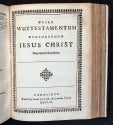

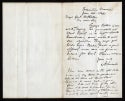
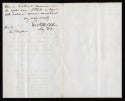






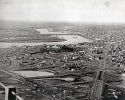










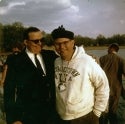


![Demonstration Info, for the first Earth Day, April 22 [1970]](/sites/default/files/Treasures-2015-Earth%20Day_Demonstration%20Info-small_thumb.jpg)
![Flyer for the first Earth Day, April 22 [1970]](/sites/default/files/Treasures-2015-Earth%20Day%20Flyer-small_thumb.jpg)







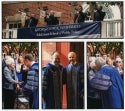







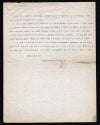


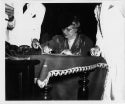


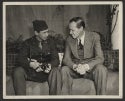






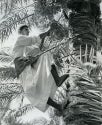






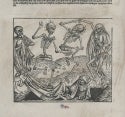








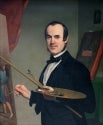












![Gianni Schicchi’s Bite from l’Infer [The Inferno]](/sites/default/files/Treasures-2015-Art31_thumb.jpg)
![Logician Devil [The Inferno]](/sites/default/files/Treasures-2015-Art21_thumb.jpg)




















